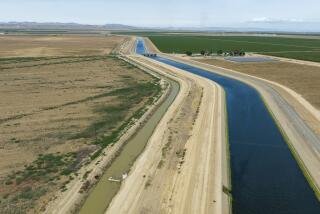Trump administration takes aim at California desert protection plan

The Desert Renewable Energy Conservation Plan covers more than 10.8 million acres. The administration’s action could also open up sensitive desert areas to off-road vehicles, mining and grazing.
- Share via
Reporting from Washington — The Trump administration is threatening to scrap a major Obama-era agreement that sought to protect millions of acres of the California desert by placing sensitive areas off-limits to major solar- and wind-energy installations.
The Desert Renewable Energy Conservation Plan covers more than 10.8 million acres and was designed to guide energy facilities to parcels where they are least likely to cause environmental damage. The administration’s announcement that it will reconsider the plan touched off an immediate backlash in the West. The Trump administration’s action could also open up sensitive desert areas to off-road vehicles, mining and grazing.
“Scrapping the plan now is a complete waste of time and money, and I oppose this,” said Sen. Dianne Feinstein (D-Calif.). Other leaders in California agreed. The California Energy Commission, which took a lead role in developing the desert management plan, says the state will have no problem meeting its aggressive clean-energy goals without rolling back the protections.
The move by the administration comes as some energy firms and local governments complained the plan was too restrictive, placing off-limits land they have been seeking to develop.
The bid to revise the plan threatens to set off new tensions between conservation groups crusading to protect habitat, such as the desert tortoise, and solar and wind developers eager to meet the West’s escalating demand for clean energy. It also raises tensions between Washington and California.
The Bureau of Land Management says it was moved to consider changing the plan “in response to President Trump’s order to review regulations that unnecessarily impede energy development.” It points out that under the conservation plan, only 7% of the millions of acres it covers is available for renewable energy leasing.
“We need to reduce burdens on all domestic energy development, including solar, wind and other renewables,” said Principal Deputy Assistant Secretary for Land and Minerals Katharine MacGregor.
The Trump administration points to California’s own aggressive mandates for renewable energy in justifying the move. It also cites complaints from the Riverside County Board of Supervisors and the Blythe City Council that the conservation plan could inhibit energy development.
Yet any changes threaten to intensify the costly and time-consuming lawsuits and bureaucratic hurdles that commercial scale projects can bring. Facilities built on land the management plan designates for them are eligible for fast-track permitting. As the Trump administration suggests unraveling the year-old management plan could speed the production of clean power in California, the states own officials say it would have just the opposite effect.
State officials are likely to fight any moves by the Trump administration to shrink the areas the plan protects. They say it is absolutely unnecessary to put commercial-scale clean-power projects in those areas to meet California’s renewable energy goals. Some also warn tearing apart the plan would undermine the state’s efforts to shift toward more clean power, exposing energy companies to the litigation and bureaucratic delays that the carefully brokered plan was designed to help them avoid.
“This is not needed,” said Karen Douglas, who is on the state energy commission. “We have sufficient land designated in this plan to support meeting our renewable energy goals.”
The administration’s proposal goes beyond exploring an expansion of the land available for solar and wind. It will also consider whether more of the desert should be opened to off-road vehicles, mining and grazing.
Alex Daue, assistant director for energy and climate at the Wilderness Society, called the action a “cynical attempt by the Trump administration to undermine both renewable energy and conservation.… Reopening the carefully crafted, balanced plan will only result in uncertainty, conflict and worse outcomes for renewable energy, recreation and conservation.”
The conservation plan, which stretches 350 miles across California, was developed over eight years. The Obama administration considered more than 14,000 public comments in developing it as a road map for renewable energy infrastructure on public land.
It set aside 3.9 million acres to be permanently protected, including the Silurian Valley and the Chuckwalla Bench. Another 1.4 million acres were designated areas of critical environmental concern. And 388,000 acres were designated as appropriate for commercial-scale renewable energy projects.
The state was a major player in the development of the plan, with the California Energy Commission on the team of agencies that oversaw it.
“It’s a balanced plan that resulted from years of careful analysis and wide-ranging community engagement,” Feinstein said. “I question the logic of reopening this carefully crafted compromise that was so recently settled.”
Renewable energy advocates say they are skeptical of the administration’s intentions. It has so far not shown itself to be particularly enthusiastic about clean power. The president recently imposed hefty new tariffs on imported solar panels over the vocal opposition of much of the industry.
The Solar Energy Industries Assn. projects the tariffs will cost 23,000 mostly blue-collar American jobs, as less solar is installed and billions of dollars of projects are scaled back because of the tariffs. And industry analysts say the tariffs are unlikely to bring back to America any of the panel manufacturing jobs Trump envisions.
Follow me: @evanhalper
UPDATES:
3:30 p.m.: The article was updated with additional reaction.
The article was originally published at 1:05 p.m.
More to Read
Get the L.A. Times Politics newsletter
Deeply reported insights into legislation, politics and policy from Sacramento, Washington and beyond. In your inbox twice per week.
You may occasionally receive promotional content from the Los Angeles Times.











